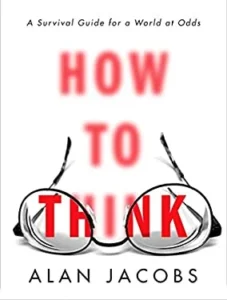 Summary: How to think is as much art as science, but it needs to become a habit to make a difference
Summary: How to think is as much art as science, but it needs to become a habit to make a difference
Alan Jacobs is one of my favorite essayists. He was a professor at Wheaton when I was there (although I never had him). He is now a professor at Baylor. I have read a number of his books, from a biography on CS Lewis to several collections of essays, to a history of the Book of Common Prayer, my favorite book on reading, a cultural history of the concept of Original Sin, and now How to Think.
I wasn’t completely sure what I was getting into when I picked this up yesterday morning (it was released yesterday). Jacobs is one of the authors I pre-order. But especially if he was writing something about how to think, I wanted to read it.
This is sort of like A Little Exercise for Young Theologians (or Letters to a Young Calvinist or one of the many other similar short books). How to Think is a book of advice written with the clear intention of helping the reader. Jacobs has taught Literature and Composition for more than 30 years. Helping people to think, write, and communicate has been the job of English Professors more than professors in most other subject areas.
Jacobs starts by taking us down a peg or two. We are not as original as we think. We are not as good at evaluating ideas as we think we are. We, like everyone else, have confirmation bias, mental shortcuts, and sloppy habits. We also probably don’t really listen all that well.
Thinking is more art than science, according to Jacobs. It is not that we cannot learn from science about how the brain works or principles of communication theory. But like many other things, thinking is something that has to be put into practice, not just studied. To put good thinking into practice, you have to surround yourself with good thinkers and then listen to them.
Jacobs is particularly interested in helping us to think in an age where tribalism is rampant. That means breaking down some of those tribal walls and listening. He cites a debating group several times that is not trying to score points but to gain understanding. One person cannot start talking until they can summarize the previous person’s thoughts in a way that the previous person agrees is accurate.
Also included are suggestions about how to avoid straw-men or ‘in other words you mean’ and other slopping thinking. Jacobs also advocates community building to allow us to express and try out ideas. There is resistance to angry responses. However, most of this is also not particularly original or new. Jacobs is an engaging writer. He has lots of stories to give context. Jacobs digs at the reader so that we can’t think that it is only ‘that other person’ who doesn’t think well. He presents the ideas that we probably should have learned and put into place earlier in a way that we can listen to now.
Like James KA Smith’s general approach to habit, we think well by making thinking something that is ritual, a habit that becomes reinforced over time.
It may stop you from reading the whole book, which I don’t want to do, but if you are thinking about the book, then pick it up at a bookstore or look at the “look inside” on Amazon and read the “Thinking Person’s Checklist” at the end of the book. If those 12 points make general sense to you, pick up the book and keep reading. The checklist is convicting. And if you are not convicted, you probably won’t benefit from the book.
How to Think is short, with 157 pages of main material. I listened to the audiobook in a day. I will probably re-read it in print again soon.
How to Think: A Survival Guide for a World at Odds by Alan Jacobs Purchase Links: Hardcover, Kindle Edition, Audible.com Audiobook
thanks for your review, I enjoyed it and also because of you I am going to read the J. Edgar Hoover book.